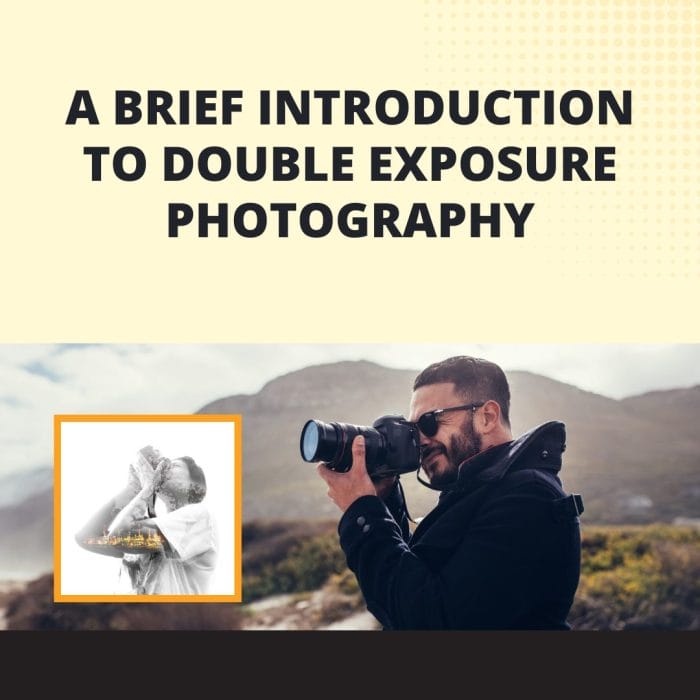Double-exposure photography is a cool way of creating art. It combines two different pictures in one frame, telling a story with layers to make it more interesting. This creative style can help business owners stand out by making eye-catching visuals that tell a story and make their brand more memorable. Let’s see how this artistic technique can make your brand’s storytelling even better.
A Brief Introduction to Double Exposure Photography
Double exposure, an intriguing blend of techniques, is a photographic method where two or more distinct images are combined to create a single compelling picture. This technique manifests a harmonious interplay between light and practice, form and function, reality and fantasy, thereby fostering a whole new dimension of visual storytelling.
Historical Context
Double exposure photography dates back to the 1860s, pioneered by William H. Mumler. To understand more about the evolution of photography techniques, check out Introduction to Double Exposure Photography, which provides a comprehensive overview. who stumbled upon it accidentally while developing a photo. His work, often featuring ghostly figures, ignited interest and set the stage for the evolution of the technique. Today, double exposure has gone digital, still mesmerizing with its multi-layered imagery.
Evolution of Double Exposure
The evolution of double-exposure photography has been marked by innovation and technology, transforming it from a simple accidental discovery into a sophisticated digital art form. The journey of double-exposure photography from a simple accidental discovery into a sophisticated digital art form is much like the evolution of web design, where innovation and technology play a pivotal role.
Transition From Film to Digital
The switch from film to digital in double exposure photography parallels advancements in web technology, as discussed in How Progressive Web Apps Work, making it more accessible and creatively versatile. In the film era, it required careful planning and guesswork to create double exposures. You had to select subjects and calculate exposure meticulously.
Notable Artists and Their Contributions
Notable artists like Harry Callahan and Man Ray have made significant contributions to double-exposure photography. Learn more about artistic contributions in Web Design Trends for Small Businesses, which highlights innovation in design. Callahan’s work showcased the symbiosis between urban landscapes and human figures, while Ray, with his ‘Rayographs’, revolutionized the technique by creating abstract and surreal images without a camera. Their artistic explorations continue to inspire the modern generation of photographers.
Techniques and Methods
This section delves into the various techniques and methods employed in double-exposure photography.
Creating Double Exposure With Film
Creating double exposure with film involves careful planning and precision. The process starts by photographing without advancing the film, keeping the same frame. Next, a second image is captured on the same structure, overlapping the two pictures. The exposure for each shot must be calculated accurately to ensure a balanced final image.
Digital methods
Digital tools have simplified double exposure photography, much like how Free Content Writing Tools assist in creating compelling web content. In the digital realm, double-exposure photography is facilitated by advanced software like Adobe Photoshop or built-in camera features. They allow photographers to overlay images, adjust their opacity, and manipulate layers for a desired creative outcome. This has vastly simplified the process, making it a popular technique among contemporary digital artists.
A Step-by-step Guide
Let’s delve into creating a double-exposure image in a few simple steps.
Subjects of Your Choice: Select two complementary images. The first, or primary image, should ideally have a clear silhouette or strong shapes. The second image, often a texture or pattern, fills this primary shape.
Capture or Open the Primary Image: Capture your primary image in the camera with the double exposure mode enabled. If you use software like Photoshop, open your primary image in the workspace.
Overlay the Secondary Image: Capture or import your secondary image. The camera or software automatically combines the two images, resulting in a double exposure effect. Adjust opacity and blending modes to fine-tune the result.
Fine-tune Your Image: Experiment with brightness, contrast, and saturation. Each adjustment can highlight or subdue elements within the double exposure, offering you full artistic control.
Tips and Tricks for Stunning Double Exposures
These insightful guidelines will aid you in mastering this art form and generate stunning, impactful images that truly resonate.
Importance of Selecting the Right Base Image
Choosing the right base image is crucial in double-exposure photography. The starting picture, usually a dark outline or a bold subject, with distinctive shapes, forms the foundation upon which the secondary image is overlaid. It dictates the overall composition and is pivotal in conveying the desired narrative or emotion, profoundly impacting the outcome.
Experimenting With Textures, Colors, and Subjects
Trying out different textures, colors, and things to photograph makes double-exposure photography more creative. Textures make the pictures more interesting, colors create a mood and feelings, and using different subjects tells different stories. Doing this exploration can give you surprising and impressive results, making your double-exposure pictures look even better.
Why Use Double Exposure?
Explore why you should incorporate this technique into your business strategy.
Aesthetic Choices and The Unique Effects it Offer
To understand how aesthetic choices impact web design, similar to how they do in photography, explore Best Web Design Trends. Double exposure photography is a special way of taking pictures. It mixes several images to tell an interesting story visually. This method can make the pictures look dreamy and unusual, grabbing people’s attention right away. It helps businesses express complicated ideas or feelings, making their branding and marketing better.
Storytelling Capabilities
Double exposure photography’s storytelling is akin to using Videos on a Website to convey a narrative. It puts different stories together in one picture, making people feel a mix of emotions and ideas. This helps businesses share complicated messages in a deep and creative way. Using this kind of storytelling can be a strong way to connect with people and make brand stories even more interesting.
Double Exposure in Modern Media
Double-exposure photography is now widely used in today’s media. It’s found in many places and styles, thanks to its unique look and storytelling ability.
Use in Movies and TV Shows
In movies and TV, double-exposure photography makes things look dramatic and kind of like they’re from another world. For example, in the opening credits of HBO’s “True Detective,” they used it to make things mysterious by putting landscapes on top of characters. Alfred Hitchcock used it in “Vertigo” to create psychological tension.
In “Blade Runner 2049,” they used double exposure to show overlapping realities and identities in a future where things aren’t so good, making the movie’s themes more complex and interesting.
For insights into other modern media techniques, read about Leveraging Social Media PR for Your Business, which discusses contemporary marketing strategies.
A blend of Technology and Artistry
Double-exposure photography is like a mix of technology and artistic imagination. With digital tools, artists can create pictures by playing with layers, transparency, and colors. This mix of technology and artistic ideas gives a lot of options, letting artists make complex and interesting pictures that tell powerful stories and evoke strong feelings.
The fusion of technology and artistry in photography is similar to User Experience and SEO, blending technical aspects with creative design in web development.
Conclusion
Double exposure photography is a cool mix of art and technology that lets you explore endless creative ideas. You can create your own unique style to make your brand’s visuals stand out. We really encourage you to try out double-exposure photography, play around with different techniques, and discover your own artistic way. It’s a fun journey!
Just as double-exposure photography invites exploration and creativity, so does the Web Design Process, which encourages experimentation in creating unique web experiences.







